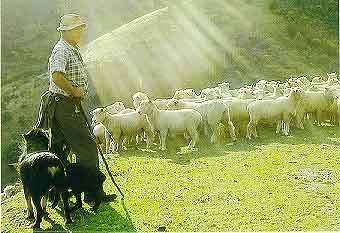 N.Z. has over 60 million sheep
N.Z. has over 60 million sheep N.Z. has over 60 million sheep
N.Z. has over 60 million sheepSheep predominate much of the pasture land, providing wool and dairy products. Timber harvesting is another large industry that effects the image of New Zealand. According to the Ministry of Forestry, the exports of all forest products were just over 1.5 billion dollars. The amount they used domestically including imports was about 850 million dollars worth. In 1989, 21,000 hectacres were planted while, 2,000,000 meters were cut down. For New Zealand's economy to benefit the most, they need to find an equilibrium between the right amount of timber harvesting and tourism. When considering the economy, tourism contributes about twice as much as does timber harvesting. When the Fourth Labour Government took control of occife in 1986, the Minister of FinanceRodger Douglas decided it would be a good idea to down-size. One of the more controversial actions he took was to get rid of the overlapping departments. Not only did he reduce the number of government jobs, he also thought it would be more efficient to let the private industry harvest New Zealand's timber fields. Many of the people who were previously employed by the country went to work for the lumber conpanies. Most of the timber that is harvested is exotic pine that grows extremely well due to the ideal conditions. Pine trees grown in N.Z. mature amost twice as fast as they would in California. Kiwi fruit and apple farming are other large industries along with fishing.